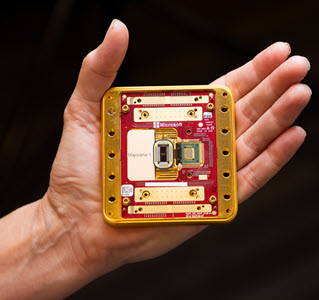
In light of recent discussions in the scientific and engineering community, I wanted to take a closer look at Microsoft’s latest announcement in quantum computing. As someone deeply interested in the intersection of research and innovation, I was curious about what this means for the field. Is this truly a turning point in quantum computing, or is there still more work to be done? As part of Now & Next, a new series dedicated to exploring current events, groundbreaking research, and forward-looking trends in engineering, this post delves into Microsoft’s research, the promise of topological qubits, and how the research community is responding. This could be the dawning age for quantum computing, or another step in a long journey. Let’s dive into what’s going on now and what’s coming next with Microsoft’s quantum computing announcement.
What’s Going On Now?
On February 19, 2025, Microsoft announced a breakthrough in quantum computing with the unveiling of the Majorana 1 chip, which the company claims is built on a “new state of matter.” This announcement, which was published alongside a peer-reviewed paper in Nature, presents Majorana-based topological qubits, an innovation that Microsoft believes will enable quantum computers to deliver transformative solutions.
Quantum computers today are extremely susceptible to noise, meaning that they are extremely error prone. The Majorna 1 chip is powered by the world’s first Topological Core, which would drastically reduce error rates, eliminating one of the biggest challenges in quantum computing.
However, the announcement has been met with mixed reactions from scientists around the world. Skeptics argue that there is a need for more evidence to validate the existence of topological qubits. Others recognize Microsoft’s research as a valuable contribution to ongoing quantum computing research, even if it falls short of being a breakthrough.
Microsoft’s Majorana 1 chip is designed to store and process information using topological qubits, a fundamentally different type of qubit than traditional superconducting qubits. Compared to current error prone qubits, topological qubits are theoretically more resilient to external noise, effectively contributing to error reduction. The basis of a more resilient topological qubit lies in its leveraging of Majorana particles. First predicted by physicist Ettore Majorana in 1937, the Majorana particle is a fermion that is its own antiparticle, meaning that it has the important characteristic of retaining information even when manipulated. This has the potential to eliminate the need for extensive quantum error correction protocols, pave the way for large-scale quantum computers, and enable the development of novel quantum algorithms. Microsoft claims that its new topological superconductor material allows for the creation of eight topological qubits on a single chip. Could this change quantum computing?
The short answer is yes. Topological qubits have the potential to revolutionize building a functional quantum computer, offering a fundamentally different and potentially superior path forward. With a functional quantum computer, current encryption algorithms will be broken, several scientific fields would reach new heights, and there will be optimization breakthroughs in multiple fields including finance and artificial intelligence.
While Microsoft’s announcement has generated significant excitement, many physicists have concerns. In 2017 and 2018, studies published by Microsoft were later withdrawn due to inconsistencies that were later revealed. Scientists have noted that the peer-reviewed paper, published in Nature alongside Microsoft’s announcement of the Majorana 1 chip, does not have sufficient evidence to back the creation of a topological qubit. Even if this doesn’t amount to a breakthrough, many find that this is making real progress towards creating a functional quantum computer.
What Comes Next?
At the American Physical Society’s annual meeting this coming March, Microsoft researcher Chetan Nayak will present further details and offer an opportunity for physicists to pose questions or concerns. While Microsoft has yet to present additional published research to validate their claims, the scientific community is holding their breath, awaiting evidence of a potential breakthrough in quantum computing.
Microsoft’s announcement has reignited the scientific discourse around topological qubits. Whether it is offering a potential alternative approach to quantum computing or a breakthrough, topological qubits have a real opportunity to change the world. With mixed reactions from the scientific community, it is up to Microsoft to share evidence that Majorana-based topological qubits can truly deliver on their promise. For now, one thing is certain: the future of quantum computing remains undeniably exciting.
—
As a computer science student, I find it fascinating to follow these developments, especially considering their potential to transform fields like cryptography and AI. Princeton’s own research community has been actively exploring quantum technologies, from superconducting qubits to quantum materials, and for students interested in exploring this field, the Princeton Quantum Initiative (PQI) provides opportunities to engage with cutting-edge research and explore the challenges of building scalable quantum systems.
I really enjoyed diving into all the buzz surrounding Microsoft’s quantum computing announcement, both in a technical capacity and in exploring the skepticism that follows bold claims in the realm of frontier technologies. I hope this article provided you with insight into the current state of quantum computing and where it might be headed. Stay tuned for more on current events, breakthroughs, and trends in the scientific and engineering community with my series, Now & Next!
Wishing you the best,

